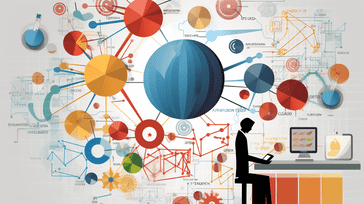The Role of GDP in Economic Indicator Analysis

Understanding the economy and its trends is crucial for investment decisions, policy-making, and overall economic stability. Economic indicators help us gauge economic health and predict future trends. One of the most important economic indicators is Gross Domestic Product (GDP). GDP measures the total value of goods and services produced within a country's borders over a specific time period, usually a year or a quarter. GDP provides valuable insights into the overall health and performance of an economy and helps us understand the direction of economic activity.
Key Takeaways:
- Gross Domestic Product (GDP) is a key economic indicator used to measure the total value of goods and services produced within a country's borders.
- GDP provides insights into the overall health and performance of an economy and helps us understand the direction of economic activity.
- Understanding GDP and its components is crucial for assessing the economic health of a nation and predicting future economic trends.
- GDP growth rate, unemployment rate, inflation rate, consumer price index, stock market performance, industrial production, and retail sales are other important economic indicators that help us gauge economic health and predict future trends.
- Accurate economic indicator analysis is crucial for investment decisions, policy-making, and overall economic stability.
Understanding GDP and its Significance
Gross Domestic Product (GDP) is widely recognized as one of the essential economic indicators for assessing the economic health of a nation. GDP measures the total value of goods and services produced within a country's borders during a specific time period, typically a quarter or a year. As such, it provides valuable insights into the overall performance of an economy.
GDP is commonly used to compare the relative economic performance of different countries. Countries with higher GDPs tend to have better access to resources and higher standards of living, while those with lower GDPs may struggle to meet the needs of their citizens.
As an economic indicator, GDP provides policymakers, analysts, and investors with essential information about the state of an economy. It allows them to identify trends, make informed decisions, and respond effectively to changes in the economic landscape.
Overall, GDP serves as a crucial tool for understanding the current economic climate and predicting future economic trends.
The Components of GDP

GDP, or Gross Domestic Product, is an important economic indicator that measures the total value of goods and services produced within a country's borders. It comprises four main components that contribute to the overall economic output: consumption, investment, government spending, and net exports.
| Component | Description |
|---|---|
| Consumption | Refers to the amount spent by households on goods and services for personal use. |
| Investment | Refers to the amount spent by businesses on capital goods such as machinery, equipment, and buildings. |
| Government Spending | Refers to the amount spent by the government on goods and services, including salaries of public employees and defense spending. |
| Net Exports | Refers to the difference between a country's exports and imports of goods and services. |
Consumption and investment are the largest components of GDP, while government spending and net exports contribute to a smaller extent. However, the exact proportion of each component can vary depending on the country's economic structure and development.
Changes in any of these components can have a significant impact on the overall GDP growth rate. For example, increases in consumer spending or business investment can lead to GDP growth, while decreases in government spending or net exports can lead to a contraction in GDP.
GDP Components: Consumption
Consumption is a critical component of GDP and is a measure of how much households spend on goods and services for personal use. It includes spending on durable goods such as cars and appliances, non-durable goods such as food and clothing, and services such as healthcare and education.
In general, higher levels of consumption indicate a healthy economy, as households are confident in their financial situation and willing to spend money. However, excessive consumption can also lead to inflation and have a negative impact on the overall economy.
GDP Components: Investment
Investment refers to the spending of businesses on capital goods such as machinery, equipment, and buildings. It is a crucial component of GDP, as it contributes to economic growth and development by increasing productive capacity and generating employment.
Increases in business investment can also lead to increases in consumer spending, as businesses hire more workers and pay higher wages. However, decreases in investment can have a negative impact on the overall economy, leading to job losses and stagnation.
GDP Components: Government Spending
Government spending is a critical component of GDP, as it contributes to the provision of public goods and services such as education, healthcare, and infrastructure. It also supports employment and stimulates economic activity.
However, excessive government spending can lead to inflation and have a negative impact on the overall economy. It is essential to strike a balance between government spending and taxation to maintain a healthy economy.
GDP Components: Net Exports
Net exports refer to the difference between a country's exports and imports of goods and services. A positive net export value indicates that the country is exporting more than it is importing, while a negative value indicates the opposite.
Net exports can have a significant impact on GDP, as they contribute to economic growth and development by increasing export earnings and reducing the country's dependence on imports. However, changes in exchange rates, global economic conditions, and trade policies can have a significant impact on a country's net exports.
GDP Growth Rate and Its Implications
The GDP growth rate is a crucial economic indicator that reflects the rate of change in a country's Gross Domestic Product over a specific period. It measures the increase or decrease in the production of goods and services in an economy, highlighting the level of economic growth or contraction.
A high GDP growth rate is a positive sign of economic growth, indicating that the economy is expanding, and there is an increase in economic activity. On the other hand, a low GDP growth rate suggests economic slowdown or recession, indicating a decrease in economic output and a contraction of economic activity.
"The GDP growth rate is a leading indicator of the state of the economy, providing valuable insights into its direction and trajectory."
GDP Growth Rate Trends
The GDP growth rate can vary widely across different countries and regions, with some countries experiencing rapid growth, while others face stagnation or recession. For instance, countries like China and India have seen high GDP growth rates over the past few decades, leading to significant economic expansion, while some European countries have experienced low growth rates, leading to economic stagnation.
| Country | GDP Growth Rate (2020) |
|---|---|
| China | 2.3% |
| United States | -3.5% |
| India | -7.7% |
The above table highlights the GDP growth rates of three major economies in 2020, showcasing the different levels of economic growth and contraction. China's positive growth rate indicates a robust economy, while the negative growth rates of the US and India suggest economic contraction and instability.
GDP Growth Rate and Economic Stability
The GDP growth rate is a vital indicator of economic stability, with high growth rates indicating a stable and expanding economy. When the GDP growth rate is high, businesses are growing, job opportunities are increasing, and the general standard of living is improving. This, in turn, leads to increased consumer spending, higher tax revenues for the government, and overall economic well-being.
On the other hand, a low GDP growth rate can cause economic instability, leading to job losses, reduced consumer spending, and decreased government tax revenues. This can further lead to a decrease in economic activity, further contraction and, ultimately, recession.
"A high GDP growth rate can signify economic stability, while a low GDP growth rate can lead to economic instability, highlighting the crucial role the indicator plays in assessing economic health."
Unemployment Rate and Its Relationship with GDP

The unemployment rate is a critical economic indicator that reflects the labor market's health and its potential impact on GDP. When the unemployment rate is high, it suggests that fewer individuals have jobs, reducing consumer spending and causing a decline in GDP. Conversely, when the unemployment rate is low, it indicates that more people are employed, leading to higher consumer spending and an increase in GDP.
The unemployment rate is influenced by several economic factors, including the overall economic conditions, business cycles, and monetary policy. During a recession, the unemployment rate typically rises, reflecting a downturn in economic activity. Conversely, during a period of economic expansion, the unemployment rate typically declines, reflecting increased job opportunities and economic growth.
The labor market's strength is a crucial component of GDP growth and stability. When more people are employed, consumer spending increases, leading to higher economic activity and GDP growth. On the other hand, high unemployment rates lead to decreased consumer spending and slower economic activity, eventually leading to a recession.
"The unemployment rate is one of the most widely used economic indicators, and for a good reason. It provides critical insights into the labor market's performance, which is a crucial determinant of economic growth and stability."
Inflation Rate and Its Impact on GDP
The inflation rate is a crucial economic indicator that measures changes in the overall price level of goods and services in an economy. It is an important factor in determining the purchasing power of consumers and the economic stability of a nation.
When the inflation rate is high, it reduces the purchasing power of consumers and increases the cost of living. This leads to a decrease in consumer spending, which can result in a slowdown in economic growth. On the other hand, when the inflation rate is low, it increases consumer purchasing power and creates a favorable environment for economic growth.
"Inflation is as violent as a mugger, as frightening as an armed robber, and as deadly as a hitman." – Ronald Reagan
Inflation can be caused by several factors, including an increase in demand for goods and services, rising production costs, and changes in government policies. Furthermore, inflation can affect the economy in different ways, depending on the type of inflation that is occurring.
There are two types of inflation: demand-pull inflation and cost-push inflation. Demand-pull inflation occurs when the demand for goods and services exceeds the supply, causing prices to rise. Cost-push inflation occurs when the cost of production increases, leading to an increase in the price of goods and services.
Overall, the inflation rate is an essential economic indicator that has a significant impact on GDP and the overall economic stability of a nation. By measuring changes in the cost of living and purchasing power, policymakers can make informed decisions about monetary policy that can help maintain a stable and healthy economy.
Consumer Price Index and its Role in Economic Indicator Analysis

Inflation is a key factor that affects the overall health of an economy. The Consumer Price Index (CPI) is a popular economic indicator that measures changes in the cost of living over time and provides valuable insights into the inflation rate. The CPI is calculated by taking the price of a basket of goods and services commonly purchased by households and comparing it to the same basket at a previous point in time. This calculation measures the change in the price level of consumer goods and services, providing a valuable tool to gauge the inflation rate.
The CPI is a crucial factor in analyzing the overall economic health of a nation, as it influences consumer behavior and can impact a range of economic indicators, including GDP, interest rates, and stock market performance. High inflation can reduce purchasing power, increase borrowing costs, and deter investment, while low inflation may suggest economic stagnation and pose risks to long-term economic growth.
The Relationship between CPI and Inflation
Typically, CPI and inflation rates follow a similar pattern. As the CPI increases, inflation rates also increase. Conversely, as the CPI decreases, inflation rates tend to decrease as well. Therefore, the CPI provides a useful tool for predicting inflation rates and understanding their impact on economic activity.
The Role of the CPI in Cost of Living Adjustments
The CPI is also used to adjust for changes in the cost of living over time. It provides a tool for determining the amount of inflation-adjusted compensation that workers receive, as well as the amount of inflation-adjusted benefits received by recipients of social security and other government programs. The CPI plays a crucial role in ensuring that inflation does not erode the purchasing power of consumers and workers alike.
Conclusion
The CPI is a valuable economic indicator that provides insight into the inflation rate, cost of living, and overall economic health of a nation. It is a crucial tool for understanding the impact of inflation on a range of economic indicators and for ensuring that the purchasing power of individuals and workers is not eroded over time.
Interest Rates and their Impact on Economic Indicators
Interest rates, as a key tool for monetary policy, have a significant impact on borrowing costs and ultimately influence economic activity. Central banks use interest rates to manage inflation, promote economic growth, and maintain stability.
The Federal Reserve, for example, adjusts its benchmark interest rate, the federal funds rate, to influence borrowing costs for consumers and businesses. Lower interest rates encourage borrowing and spending, while higher rates can curb inflation and prevent economic overheating.
| Impact of Interest Rates on Economic Indicators | Effect |
|---|---|
| Inflation | Higher interest rates can reduce inflation by making it more expensive to borrow and spend money, while lower rates can stimulate inflation by making borrowing and spending cheaper. |
| Borrowing Costs | Higher interest rates increase borrowing costs for consumers and businesses, while lower rates make borrowing cheaper and more accessible. |
| Investment | Higher interest rates can discourage investment by making borrowing more expensive and reducing the potential return on investment. Lower rates can stimulate investment by making borrowing cheaper and more attractive. |
| Exchange Rates | Higher interest rates can strengthen a currency by making it more attractive to foreign investors seeking higher returns, while lower rates can weaken a currency by making it less attractive to investors. |
Interest rates, therefore, play a crucial role in economic indicator analysis. Changes in interest rates can have far-reaching implications for inflation, borrowing costs, investment, and exchange rates, providing key insights into overall economic performance and stability.
Stock Market Performance as an Economic Indicator
The stock market is an important indicator of the overall economic outlook, reflecting the sentiments of investors and businesses about the future prospects of the economy. The stock market performance is influenced by various factors, such as interest rates, inflation, geopolitical events, and corporate earnings. As such, it provides a valuable insight into the broader economic performance and the outlook for the future.
Investor sentiment is a crucial aspect of the stock market performance and can indicate how positive or negative investors are feeling about the economy. Positive investor sentiment is often associated with expectations of economic growth and stability, leading to increased investments and higher stock prices. In contrast, negative investor sentiment can result in lower stock prices and a pessimistic outlook for the economy.
It is important to note that the stock market performance does not always reflect the reality of the broader economic conditions, and the correlation between the two can be complex. Nevertheless, by analyzing the stock market performance alongside other economic indicators, such as GDP, retail sales, and industrial production, we can gain a more comprehensive understanding of the current and future economic trends.
"The stock market is a device for transferring money from the impatient to the patient." - Warren Buffet
Industrial Production and Its Importance in Economic Indicator Analysis
Industrial production is a crucial economic indicator that measures the output of the manufacturing sector. This data helps analysts and policymakers evaluate the overall health of the economy, as well as specific industries within it.
The manufacturing sector is a significant contributor to the US gross domestic product (GDP), accounting for over 11% of the total output. As a result, changes in industrial production can have a significant impact on economic growth.
For example, a rise in industrial production indicates that factories are producing more goods, which may also lead to increased hiring and economic growth. Conversely, a decline in industrial production might signal that manufacturing activity is slowing down, leading to decreased hiring and a potential economic slowdown.
The Components of Industrial Production
Industrial production consists of three main components:
- Manufacturing
- Mining
- Utilities
The manufacturing component is the most crucial, accounting for the majority of industrial production. This sector produces a range of goods, including vehicles, machinery, electronics, and textiles.
The mining component includes the extraction of minerals, oil, and natural gas, while the utilities component comprises the production and distribution of electricity, gas, and water.
Impact on the Economy
The manufacturing sector is a significant contributor to employment and exports. Therefore, changes in industrial production can impact the labor market and international trade.
For example, if industrial production declines, factories may reduce their workforce to cut costs. Alternatively, if industrial production increases, factories may hire more workers to keep up with demand. A rise in industrial production can also boost exports, as it indicates a robust manufacturing sector that is capable of producing and selling goods on a global scale.
Conclusion
Industrial production is a crucial economic indicator that provides valuable insights into the manufacturing sector's health and the overall economy's performance. Policymakers and analysts use this data to monitor economic growth and identify potential areas of concern that require attention. The manufacturing sector's strength is vital to the US economy, making the analysis of industrial production a crucial component of economic indicator analysis.
Retail Sales and their Role in Economic Indicator Analysis
Retail sales are a critical component of economic activity as they reflect consumer spending habits. Consumer spending represents a significant portion of the Gross Domestic Product (GDP), making retail sales a vital economic indicator for understanding economic growth and direction.
The total retail sales data is collected and reported by the U.S Census Bureau, and it includes sales from all retail and food service businesses, such as grocery stores, restaurants, and e-commerce websites. It also tracks changes in consumer behavior, including shifts in spending patterns across different product categories, such as durable goods like appliances and non-durable goods like clothing and personal care products.
For example:
| Month | Retail Sales Growth |
|---|---|
| January 2020 | 0.2% |
| February 2020 | 0.4% |
| March 2020 | -8.7% |
The table above illustrates the changes in retail sales growth from January to March 2020. January and February showed slight increases, but in March, retail sales decreased by 8.7%. This data reflects the onset of the COVID-19 pandemic in the United States, which resulted in fewer people shopping in person and more people ordering products online.
The data from retail sales reports can provide significant insights into the health of the economy, indicating whether consumers are confident in their financial stability and willing to spend money. Increases in retail sales can stimulate economic growth, while decreases can lead to economic downturns. The data can also help businesses adjust their marketing strategies and adapt to changing consumer habits.
- Retail sales provide valuable insights into consumer spending habits and reflect economic activity.
- The U.S Census Bureau collects and reports total retail sales data, including shifts in spending patterns across different product categories.
- The data reflects the health of the economy and can help businesses adjust their marketing strategies and adapt to changing consumer habits.
Conclusion
In conclusion, economic indicators play a vital role in assessing the health and performance of an economy. Among these indicators, GDP is perhaps the most significant and widely used metric for analyzing and predicting economic trends.
As we have discussed, GDP measures the total value of goods and services produced within a country's borders and is composed of various components, including consumption, investment, government spending, and net exports. The growth rate of GDP provides insights into the overall economic expansion or contraction, and changes in unemployment, inflation, interest rates, stock market performance, industrial production, and retail sales can all affect GDP performance.
By analyzing these economic indicators, we can gain valuable insights into the economic trends of a nation. Whether we are assessing the health of a local economy or forecasting global economic performance, understanding economic indicators and analyzing GDP is crucial.
Overall, economic analysis and evaluation are essential tools for decision-makers in business, government, and academia. A thorough understanding of economic indicators and GDP can help individuals and organizations navigate economic trends and make informed decisions that support growth and prosperity.
FAQ
What is GDP?
GDP stands for Gross Domestic Product and measures the total value of goods and services produced within a country's borders.
Why is GDP important?
GDP is an essential economic indicator that provides insights into the overall health and performance of an economy.
What are the components of GDP?
The components of GDP include consumption, investment, government spending, and net exports.
What does GDP growth rate indicate?
A high GDP growth rate signifies economic expansion and stability, while a low growth rate may suggest a slowdown or recession.
How does the unemployment rate relate to GDP?
Changes in the unemployment rate can reflect shifts in economic activity and affect overall GDP performance.
How does inflation impact GDP?
Inflation affects purchasing power, consumer behavior, and overall economic stability, all of which can have an impact on GDP.
What is the Consumer Price Index?
The Consumer Price Index (CPI) measures changes in the cost of living and inflation, providing valuable insights into economic performance.
How do interest rates influence economic indicators?
Changes in interest rates can influence consumer spending, investment decisions, and overall economic activity.
What can stock market performance tell us about the economy?
Stock market trends and investor sentiment can provide insights into the overall economic outlook.
Why is industrial production an important economic indicator?
Industrial production reflects shifts in the manufacturing sector and can provide insights into overall economic growth.
What role do retail sales play in economic indicator analysis?
Retail sales reflect shifts in consumer spending and can provide insights into overall economic activity.
